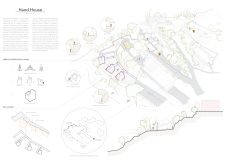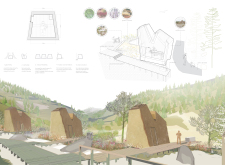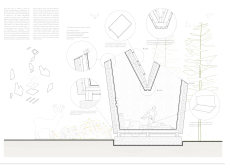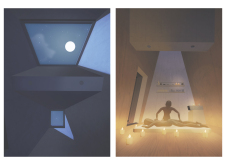5 key facts about this project
Functionally, the Hand House is designed to accommodate personal and communal activities. The layout features multiple cabins that are strategically clustered to create a sense of unity while maintaining individual privacy. This arrangement promotes social interaction while providing the necessary spaces for contemplation and relaxation. Each cabin within the project is uniquely constructed, offering various experiences that cater to a range of activities, from quiet meditation to community gatherings. The overall design allows for a fluid transition between indoor and outdoor spaces, reinforcing the connection to nature.
A key aspect of the project is its materiality, which plays a significant role in expressing the architectural vision. Recycled wood, clay, and concrete are among the primary materials used, chosen for their ecological benefits and aesthetic qualities. The choice of materials is deliberate, contributing both to the sustainability of the house and to the visual narrative that the design conveys. The use of clay for external walls reflects a commitment to natural aesthetics while providing excellent thermal insulation. Similarly, the recycled wood enhances the structure's warmth and organic feel.
Design details further enhance the project's uniqueness. The roof structure, often inspired by the imagery of hands, is a significant architectural gesture that not only adds visual interest but also serves practical functions such as enhancing natural ventilation and collecting solar energy. The roof’s form facilitates natural light to permeate into the living spaces, creating an inviting atmosphere that changes with the time of day. This dynamic interplay of light and space reinforces the project’s underlying commitment to well-being and comfort for its occupants.
Outdoor features are equally important in defining the Hand House. Thoughtfully designed pathways and decks ensure easy circulation while encouraging engagement with the surrounding landscape. The integration of an edible garden is especially noteworthy, as it serves both a functional and aesthetic purpose, encouraging occupants to participate in sustainable practices.
The architecture of the Hand House embodies a blend of innovation and tradition, effectively addressing modern needs while remaining grounded in the principles of environmental stewardship. Through its engaging design, the project challenges conventional residential layouts by creating spaces that promote interaction, connectivity, and a deeper appreciation of nature.
To fully appreciate the depth of this project, readers are encouraged to explore the detailed architectural plans and sections, which provide insight into the spatial organization and design intentions. An examination of the architectural designs and ideas behind the Hand House will reveal further layers of meaning and function, illustrating how thoughtful architecture can enrich the lives of its users and their relationship with the landscape.


























